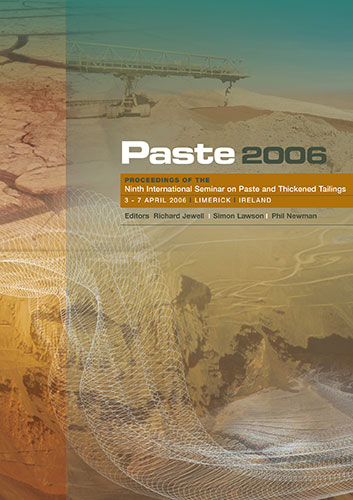Stability of Tailings Beach Slopes

|
Authors: Barrera, S; Riveros, C |
DOI https://doi.org/10.36487/ACG_repo/663_15
Cite As:
Barrera, S & Riveros, C 2006, 'Stability of Tailings Beach Slopes', in R Jewell, S Lawson & P Newman (eds), Paste 2006: Proceedings of the Ninth International Seminar on Paste and Thickened Tailings, Australian Centre for Geomechanics, Perth, pp. 169-179, https://doi.org/10.36487/ACG_repo/663_15
Abstract:
The technology of paste and thickened tailings allows for the disposal of tailings with a much steeper slope than that of conventional tailings. This characteristic together with a proper tailings management allows for tailings storage with a much smaller dam and, therefore, lower costs. Obviously this greater storage capacity for a smaller dam represents an advantage as long as the deposited tailings are stable with time. It is in this aspect where the tailings characteristics and geotechnical behaviour of the paste and thickened tailings are relevant to estimate and assure the tailings stability. This is especially critical in areas of high seismicity and/or intense rainfalls. It should be noted that some aspects of the behaviour of conventional tailings (the product from flotation whose slurry has a Newtonian hydraulic behaviour) has not received much attention, and, in particular, its mechanical residual strength has been disregarded in most of the stability analysis of tailings dams. The evidence that the tailings may achieve steeper slopes than those assumed by general practice and the advantages that this entails have made it necessary to analyze in greater detail the strength of this material. However, this lack of knowledge is valid for the behavior of tailings beaches subjected to intense precipitation. With tailing beach slopes less than 0.5%, the subject of tailings displacement by rains and the subsequent erosion was not relevant, particularly when the beaches are small in area. But the application of this thickening technology to impoundments with surfaces greater than 100 or 200 ha could imply the eventual removal of 1 to 2 millions of cubic meters (Mm3) only as a consequence from a 100 mm precipitation, if the tailings do not present cohesion or a matrix that allows it to resist the erosion forces of the surface runoff. Given that this technology has been applied very recently, there is very little experience of the real behavior of the thickened or paste tailings and these tailings may, once deposited, present a different behavior than conventional tailings. The objective of this paper is to characterize this material based on available information and studies as well as to propose some methodology to estimate the stability of the beaches of the tailings impoundments.
References:
Barrera, S. (1998) Deposition densities of tailings in Chilean deposits, Tailings and Mine Waste ‘98, Colorado. USA.
Barrera, S. (2005) Aspects to be considered in dynamic stability analysis, Thickened Tailings and Paste Seminar, Santiago, Chile.
Blight, G. (1987) The concept of the master profile for tailings dam beaches, International Waste Management Conference,
Johannesburg, South Africa.
Shuttleworth, J.C., Thompson, B.J. and Wates, J.A. (2005) Surface paste disposal at Bulyanhulu – practical lesson learned,
Proceedings of the International Seminar on Paste and Thickened Tailings, Santiago, Chile.
Sofra, F. and Boger, D. (2001) Slope prediction for thickened tailings and pastes, Tailings and Mine Waste ‘01, Colorado, USA.
Theron, M., Addis, P.C., Wates, J.A. and Martin, V. (2005) Bulyanhulu mine (Tanzania) paste tailings facility: relating the
unsaturated properties of gold tailings to rate of rise, Proceedings of the International Seminar on Paste and Thickened Tailings,
Santiago, Chile.
Verdugo, R. and Ishihara, K. (1993) Undrained response of silty and sandy soils, Tercer Congreso Chileno de Ingeniería Geotécnica,
La Serena, Chile.
Wilson, K.C. and Thomas, A.D. (1985) A new analysis of the turbulent flow of non-Newtonian fluids, Can J Engng, 63, pp. 539-546.
Paste2006,Limerick,Ireland 179
surfAce disPosAl
© Copyright 2025, Australian Centre for Geomechanics (ACG), The University of Western Australia. All rights reserved.
View copyright/legal information
Please direct any queries or error reports to repository-acg@uwa.edu.au
View copyright/legal information
Please direct any queries or error reports to repository-acg@uwa.edu.au